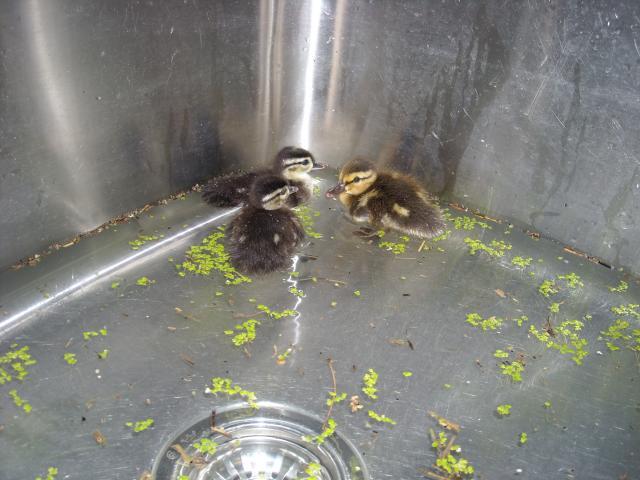Hello there!
The ducklings are just about a month old now and have most of their feathers. I have to say, there's some pretty looking ducks in this bunch. There's 9 in this photo. I think Tiny -- the littlest one that we didn't think was going to make it -- is getting squished behind the others.

They definitely have runner in them, or are at least heavily influenced by the runner mixes in there. They're all a bunch of giant spazzes, even after we've been handling them and staying around them. This is pretty much what they do a lot of:

We've been able to pull a couple out and in pairs they quiet down. They're just starting to discover their quacks, and it's hilarious to hear peep-peep-peep-HONK-HONK-peep-peep.

Today, though, we were driving to lunch and saw a puff ball with legs running around in the middle of the street. We caught the little guy, but there's no ducks anywhere near this. Since we have the brooder still sitting around, we're going to help it out until it gets some feathers and then try and release it again, I guess. It can't be more than a week old, given its size, otherwise we'd just let it stay outside.
I'm guessing mallard. K seems to think it could be a wood duck or a muscovy. There's lots of mallards and muscovies on the bayou not too far from here, but I'm guessing a muscovy would be larger. Wood ducks are common in Louisiana, though ... I suppose we'll just have to wait and see!

Once the 9 have their full set of feathers and a little more heft, we might try and see about mixing them in with the adults. Right now we have them separated. Any tips on making the introduction of young ducks go smoothly?
The ducklings are just about a month old now and have most of their feathers. I have to say, there's some pretty looking ducks in this bunch. There's 9 in this photo. I think Tiny -- the littlest one that we didn't think was going to make it -- is getting squished behind the others.
They definitely have runner in them, or are at least heavily influenced by the runner mixes in there. They're all a bunch of giant spazzes, even after we've been handling them and staying around them. This is pretty much what they do a lot of:
We've been able to pull a couple out and in pairs they quiet down. They're just starting to discover their quacks, and it's hilarious to hear peep-peep-peep-HONK-HONK-peep-peep.

Today, though, we were driving to lunch and saw a puff ball with legs running around in the middle of the street. We caught the little guy, but there's no ducks anywhere near this. Since we have the brooder still sitting around, we're going to help it out until it gets some feathers and then try and release it again, I guess. It can't be more than a week old, given its size, otherwise we'd just let it stay outside.
I'm guessing mallard. K seems to think it could be a wood duck or a muscovy. There's lots of mallards and muscovies on the bayou not too far from here, but I'm guessing a muscovy would be larger. Wood ducks are common in Louisiana, though ... I suppose we'll just have to wait and see!

Once the 9 have their full set of feathers and a little more heft, we might try and see about mixing them in with the adults. Right now we have them separated. Any tips on making the introduction of young ducks go smoothly?





